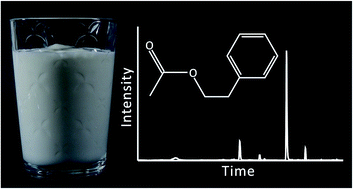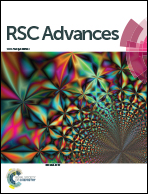On the dynamics of kefir volatome†
Abstract
Probiotic drinks constitute an important component of the daily diet in the modern society. They contain active microbial strains, which contribute to the chemical composition of these dairy products. The metabolic activity of microbes can affect the flavor and smell of probiotic drinks at room temperature. “Kefir” is an example of fermented milk, which contains various species of bacteria as well as fungi (yeast). In order to gain a better understanding of the metabolic processes shaping the chemical composition of kefir drinks, in the present study, we perform a comparative analysis of volatomes of kefir and single-species cultures of Saccharomyces cerevisiae. Gas chromatography coupled with mass spectrometry enabled the monitoring of volatile metabolites collected onto solid phase microextraction fibres (divenylbenzene/carboxen/polydimethylsiloxane). The temporal profiles of secondary metabolites (isopentyl acetate, ethyl hexanoate, ethyl octanoate, phenethyl acetate, and ethyl decanoate), present in S. cerevisiae cultures and commercial kefir, exhibit similarity. This points to a significant contribution of Saccharomyces strains on the dynamics of the chemical composition of kefir during storage at ambient conditions. On the other hand, commercial yogurt, which contains various species of bacteria but not yeast is much more chemically stable and does not exhibit rapid changes in the ester-type metabolites, which are typical of kefir.


 Please wait while we load your content...
Please wait while we load your content...